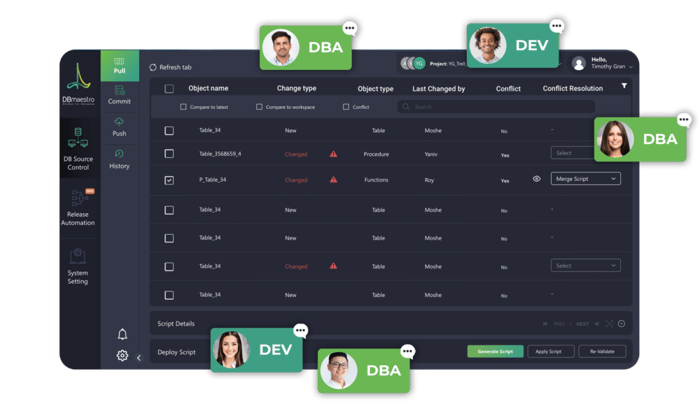
What is Database Source Control
Database source control is the process of managing and tracking changes to the source code of a database schema, including tables, views, stored procedures, and other database objects. It involves using version control software to track modifications made to the database schema and ensure that changes are properly tracked and audited.
The process of database source control involves checking out a database schema file from a version control system, making changes to the schema file, and then checking the file back into the version control system. This allows multiple developers to work on different parts of the schema simultaneously and ensures that changes are properly tracked and audited.
Database source control allows developers to manage the changes to a database schema like they manage changes to other code repositories. This helps reduce errors and ensure changes are properly documented and audited.
Overall, database source control provides developers with a powerful tool for managing changes to a database schema, promoting collaboration, and ensuring that changes are properly tracked and audited.
Benefits
There are several benefits to implementing database DevOps:
-
Accuracy: With database source control, all changes made to a database schema are tracked and recorded in a centralized repository. This helps to ensure that changes are accurately documented and can be easily reviewed or audited later.
-
Collaboration: Database source control enables multiple developers to work on the same database schema at the same time without the risk of overwriting or conflicting with each other's work. This promotes collaboration, improves team efficiency, and allows for faster development cycles.
-
Quality: Database source control helps to ensure the quality of a database schema by providing a clear record of all changes made over time. This can be useful for identifying and addressing issues, optimizing performance, and reducing the risk of errors.
-
Recovery: In the event of a disaster or database failure, having a comprehensive history of changes to a database schema can be invaluable for recovery efforts. With database source control, it is possible to quickly restore a previous version of the schema, minimizing downtime and data loss.
-
Compliance: Many industries and regulatory bodies require that changes made to databases be properly documented and audited. Database source control can help ensure compliance with these requirements, reducing the risk of fines, penalties, or legal issues.
Intro to DBmaestro Database Source Control
If you want to implement database source control, DBmaestro's Database Source Control which is an end-to-end ci/cd for your database.

Source Control is part of the DBmaestro's database DevOps Platform that utilizes change code dry-runs and tracks change code compatibility, pointing to coding errors, highlighting potential security breaches, and any potential deviation from the corporate policy.
Feature of Source Control
-
Seamless integration with all sources of database changes throughout all environments
-
Make it simple for Devs, DevOps, and DBAs to work together to accelerate release speed
-
Support speed while improving quality
-
Automatically generate and test database change scripts
-
Enforce change procedures and reduce application downtime caused by database-related errors
-
Identify conflicts and merge different development branches while getting a full view of all committed changes
-
Boost productivity and time to market
-
A single trusted point of control for consolidating the change history from several development branches and database servers
-
Always have full visibility of who made changes and what changes were made, where, and why
-
Creating isolated development databases as simple as creating new git branches
-
Parallel feature development with the help of Source Control and DB GitFlow
-
Database as Code approach to use the power of source control
-
Promoting only selected features from common test environment to higher level environments
Conclusion
Database source control is an essential tool for any developer working with databases. By providing a centralized repository for tracking changes and promoting collaboration among developers, database source control helps to improve the efficiency and reliability of database development and maintenance.
Implementing database source control requires choosing a version control system, creating a repository, setting up your database schema files, checking out the schema files, making changes, checking the files back in, merging changes, resolving conflicts and deploying changes.
With database source control in place, you can be confident that your database schema changes are accurately tracked, documented, and audited and that your development team is working efficiently and collaboratively to deliver high-quality databases.
If you are interested and want to learn more about how DBmaestro can help you start with source control, check here!


